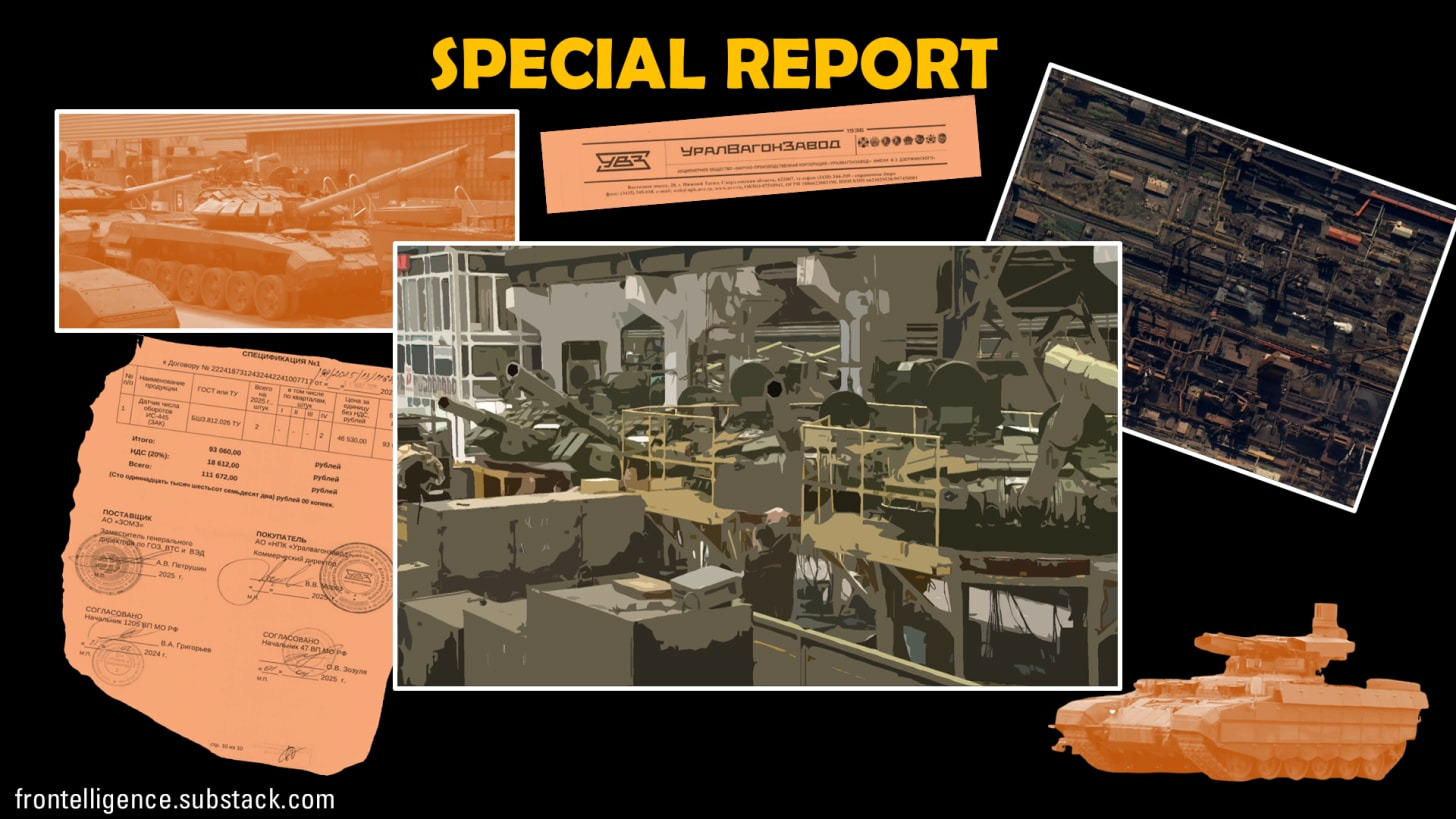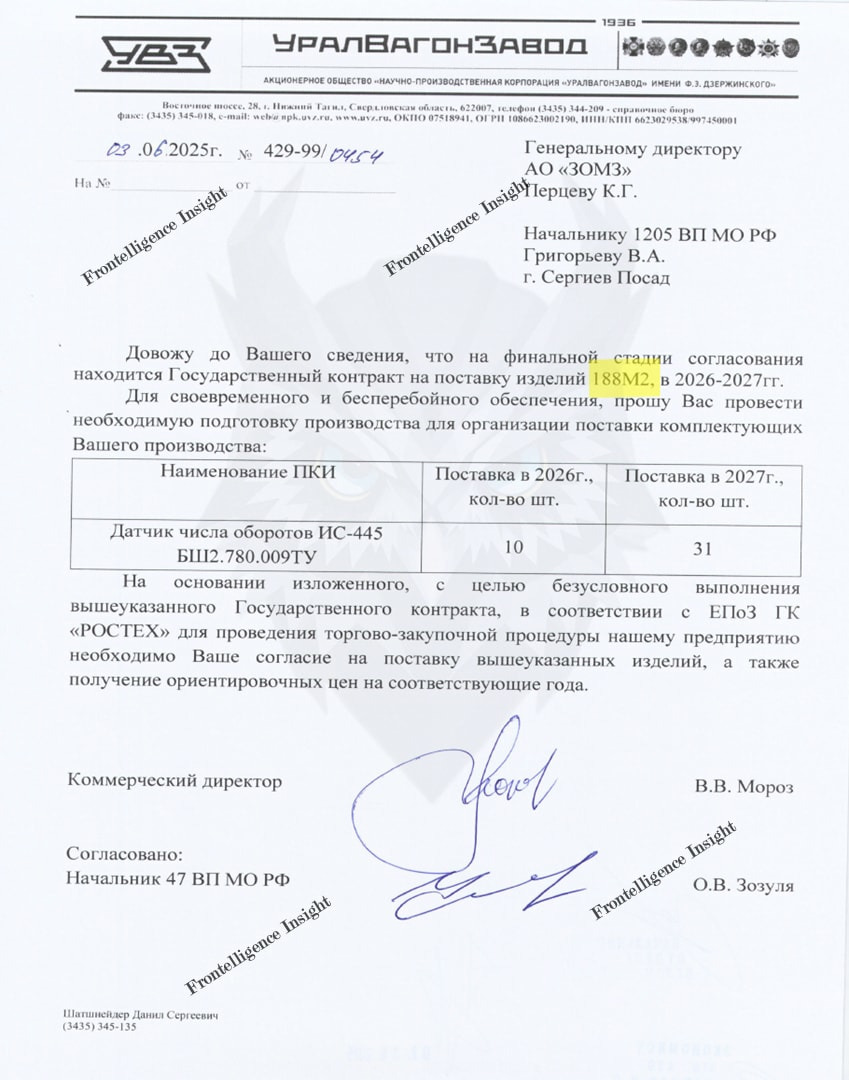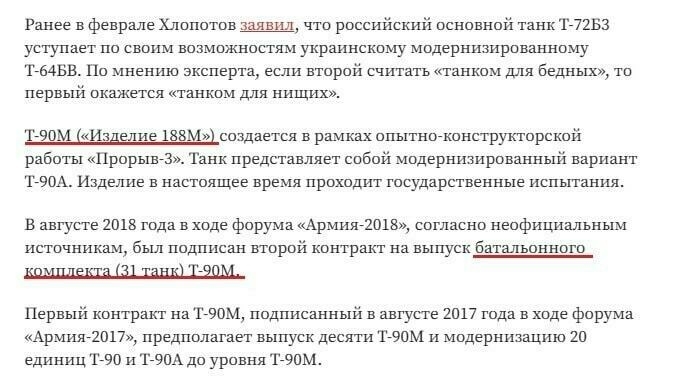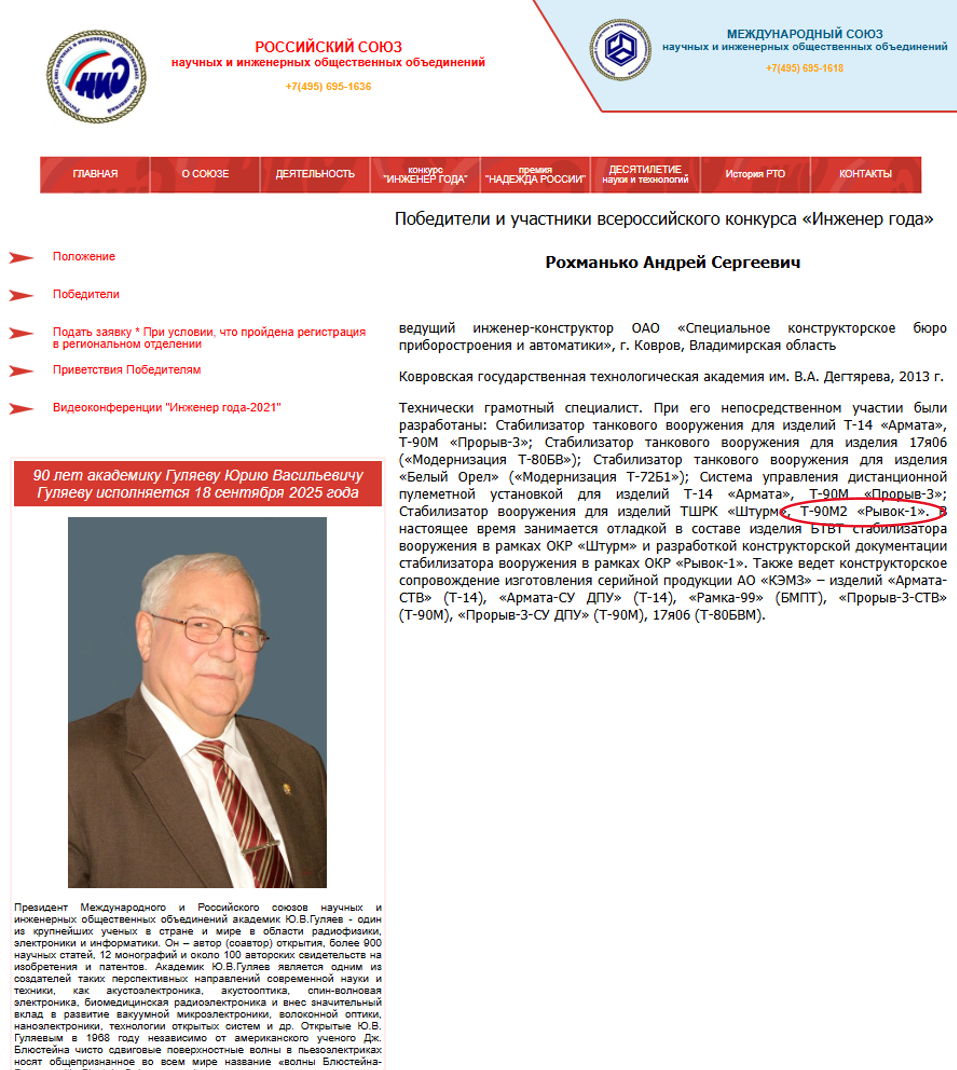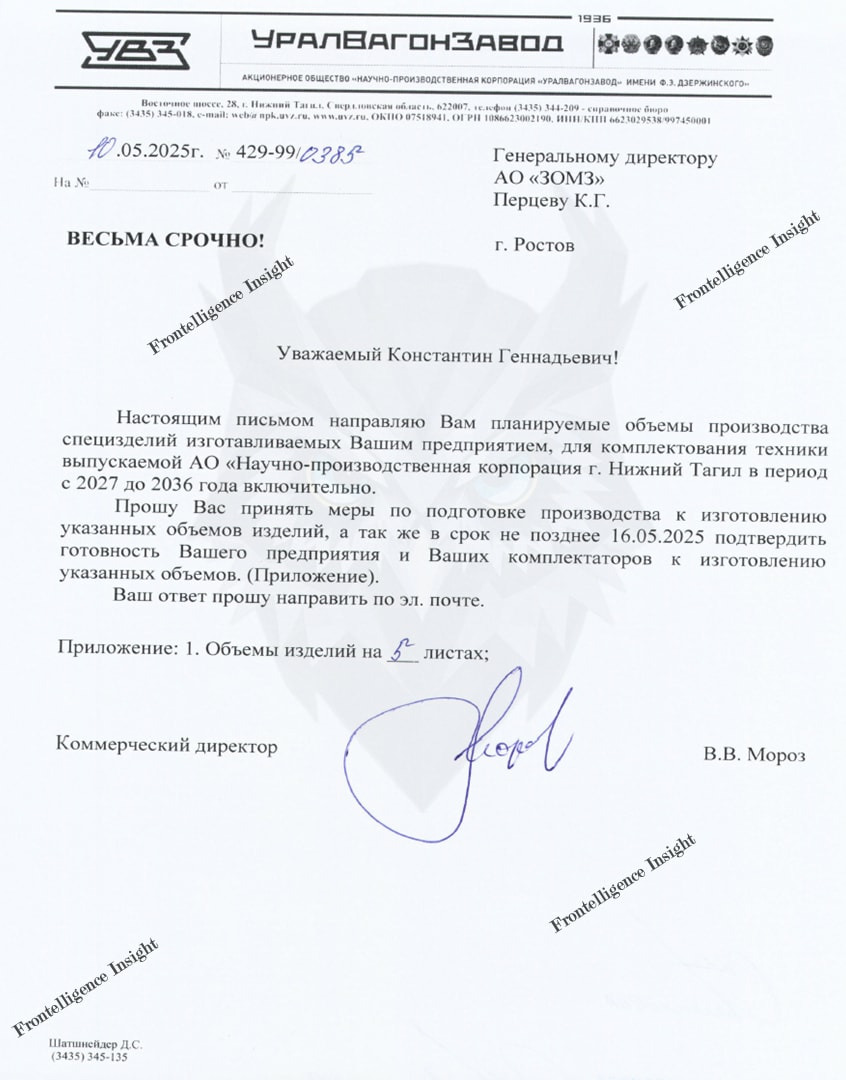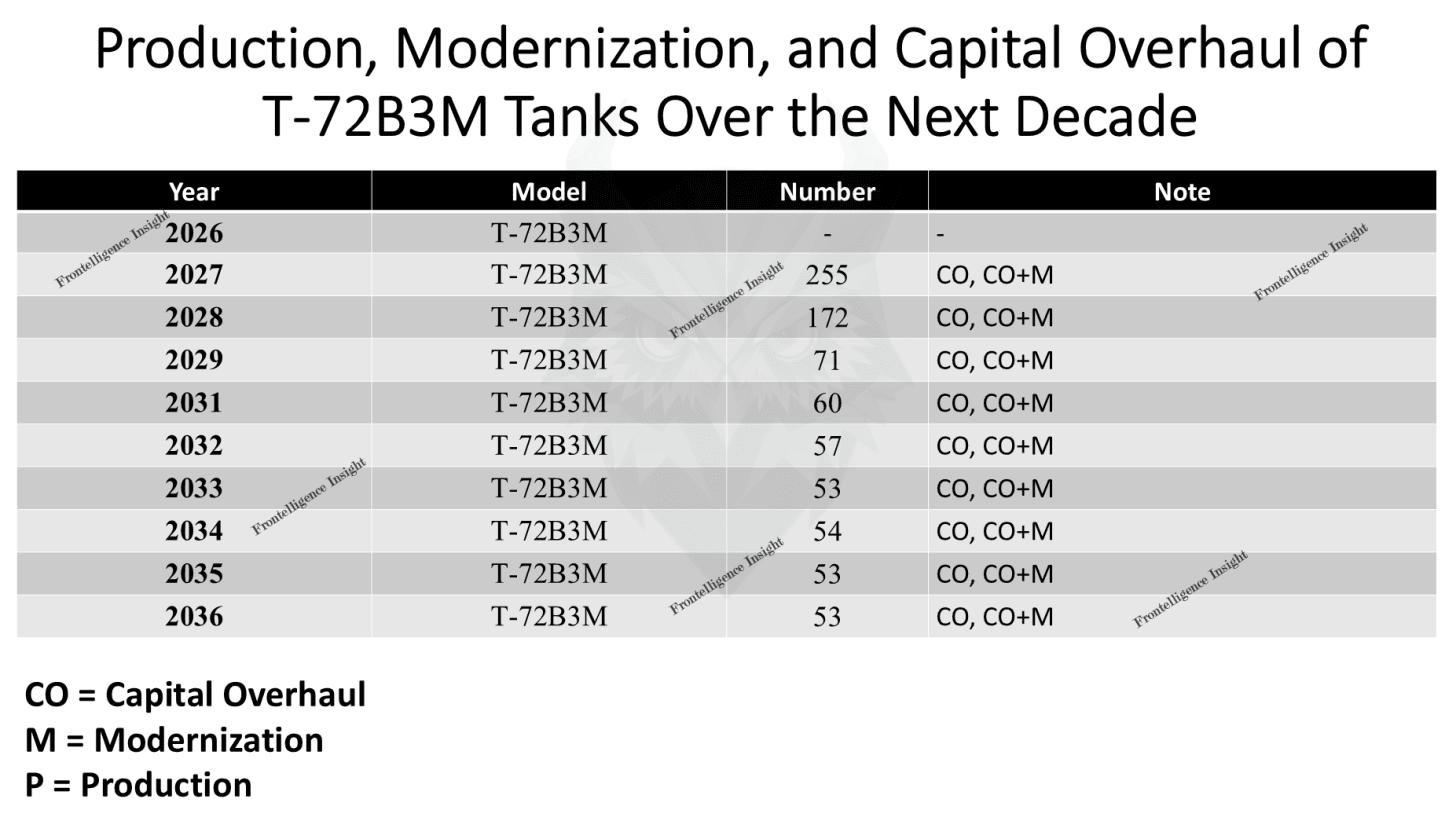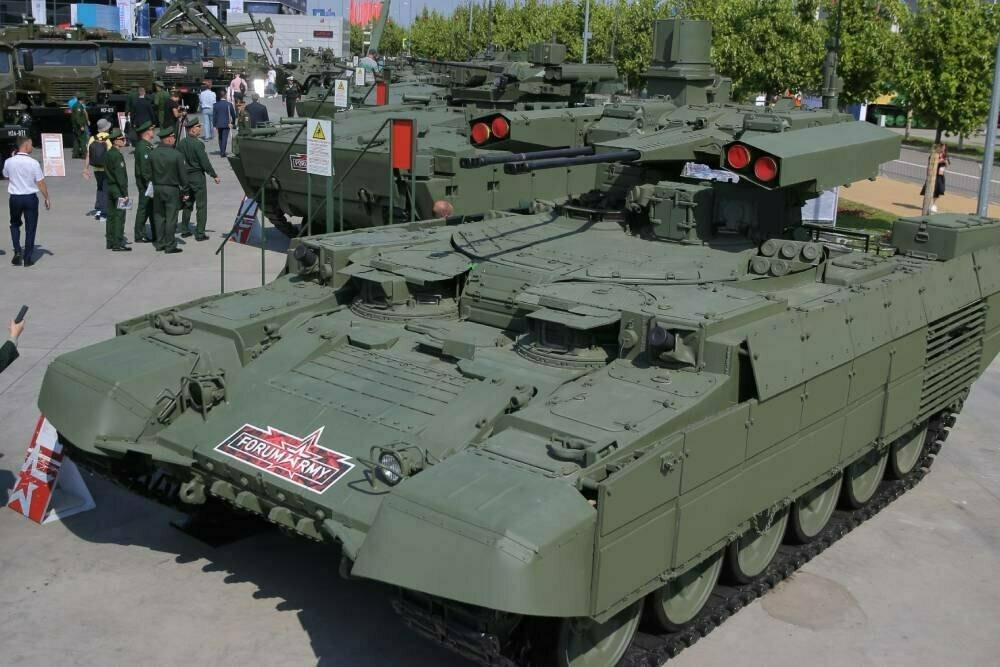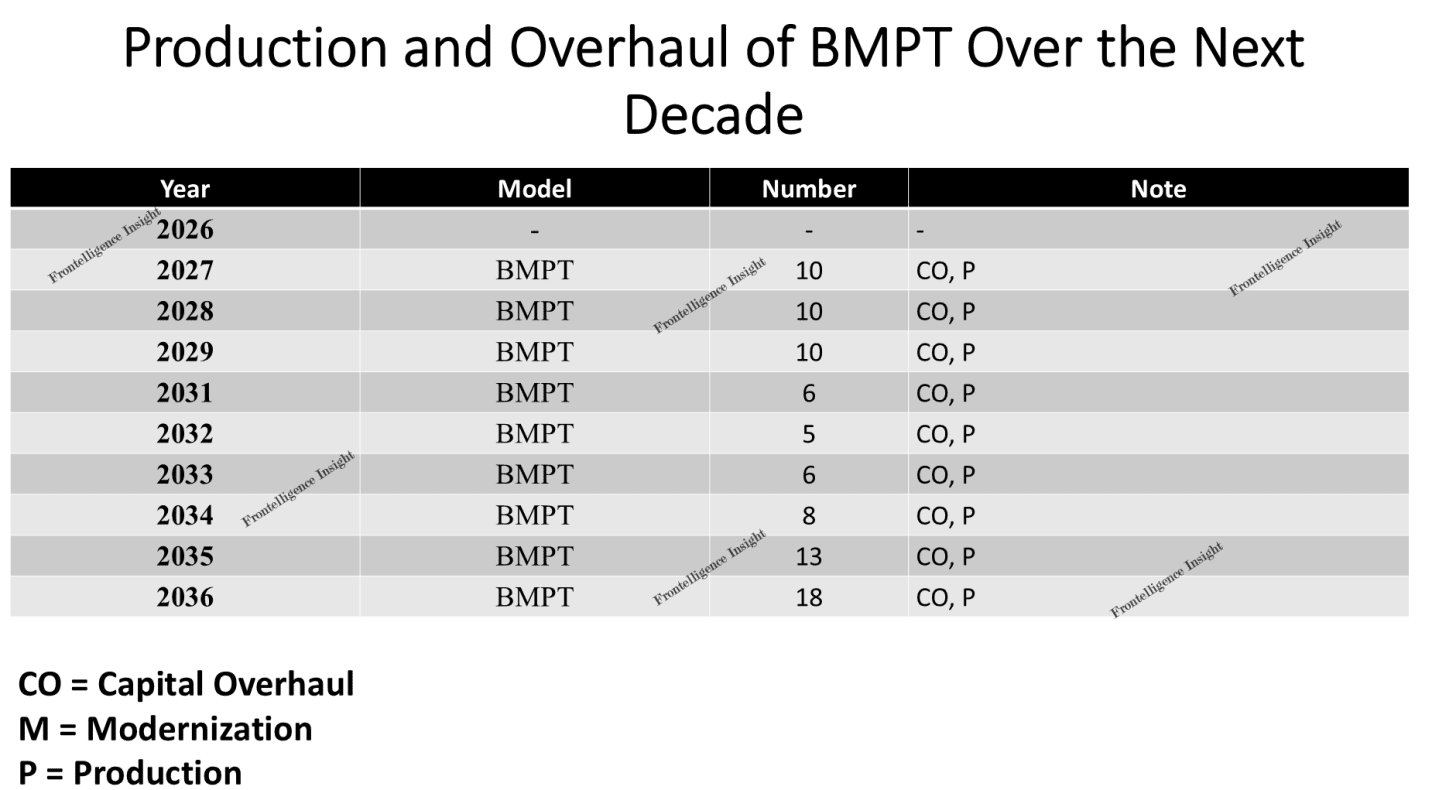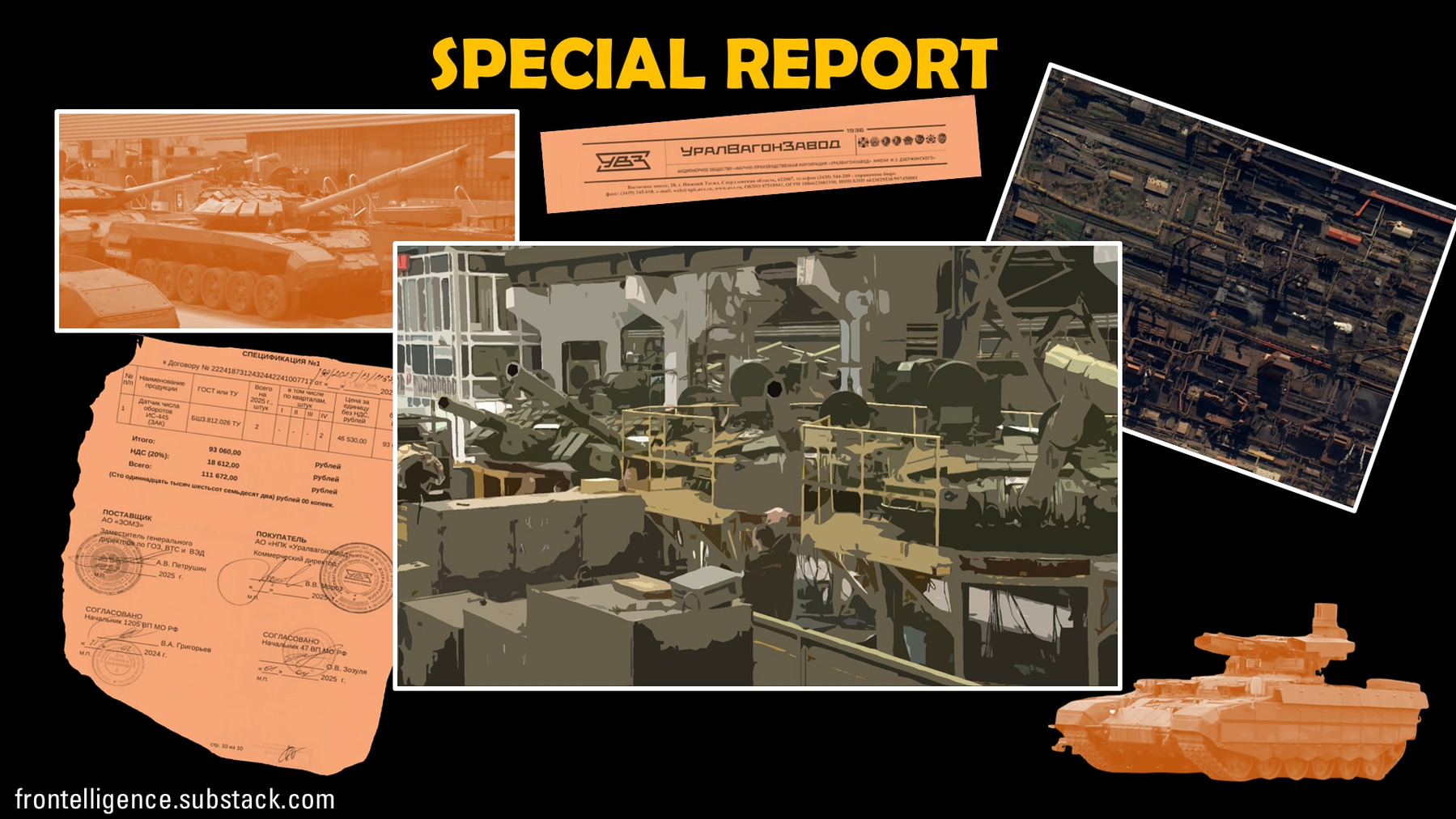
In the spring and summer of 2025, as part of our own operation, our team obtained exclusive documents that provide new insight into Russia’s tank-production plans and confirm the existence of a little-known variant of the latest Russian tank. The records indicate that by 2028, output of the T-90M and its new variant, the T-90M2, is expected to increase nearly 80% compared with 2024 levels.
The T-90M2, also known as “Ryvok-1”, is scheduled to begin modestly, with just 10 units planned for 2026. However, Russia’s long-term production plan points to far more ambitious goals: between 2026 and 2036, Moscow intends to build at least 1783 T-90M and T-90M2 tanks, with 1118 of them slated for completion in the three-year period from 2027 to 2029.
Table of Contents
I. Product “188М2”
II. Counting T-90s
III. T-72: Old but Modernized
IV. Terminated?
One of the most pressing questions for analysts, military planners, intelligence agencies, and policymakers is whether Russia intends to refit, expand, or even downsize its forces in the coming years. Often, the clearest insight into an adversary’s intentions comes not from official statements but from the way it allocates resources.
The invasion of Ukraine, the largest war Russia has undertaken since World War II, has compelled Moscow to reevaluate many of its recent military ideas, particularly after confronting a peer adversary supported by Western technology and economic resources. Drawing on these lessons, Russia is adjusting where necessary while simultaneously reinforcing and scaling its most successful practices.
Despite widespread skepticism about the relevance of tanks on a battlefield increasingly shaped by drones, Russian T-90 production remained robust in 2024, reaching roughly 240 units, including both overhauled and modernized vehicles, according to a well-placed analyst. This report not only indirectly confirms his words, but also shows that Moscow does not intend to scale back; on the contrary, it plans to expand modern tank production - a development that may provide a clear answer to the question of its future military posture.
I. Product “188М2”
Our investigation began with what appeared to be a routine document in our hands: a letter from Uralvagonzavod, Russia’s largest tank manufacturer, to the Zagorsk Optical-Mechanical Plant (ZOMZ) and a Defense Ministry representative. The company requested parts designated IS-445 for a project identified only as “Product 188M2.” At first, the document seemed unremarkable. But a closer look revealed it as a doorway to a much larger story.
A quick check against public sources helped connect the dots. A 2019 article by the Russian outlet Lenta mentioned “188M” as the codename for the T-90M “Proryv-3.” While not definitive, this suggests that the “2” in “188M2” likely indicates a successor or upgraded modification of the T-90M.
That theory gained traction when we found a reference in the Russian Union of Scientific and Engineering Public Associations listing a lead design engineer as one of the developers of the T-90M2 “Ryvok-1,” which translates as “Dash-1.” While the evidence was indirect and somewhat unconventional, it nonetheless offered credible confirmation of the T-90M2’s existence.
At that point, the trail went cold. Further open-source investigation produced little beyond speculation and unreliable chatter. To move forward, we returned to documents, which revealed more than expected.
II. Counting T-90s
The breakthrough came from the IS-445 part itself. We followed up on the reference in the first document, which listed a supply of IS-445 units for “Product 188M2.” That detail suggested the number of sensors ordered could, in fact, correspond to the number of vehicles being produced. To test this assumption, we consulted both military vehicle specialists and manuals for the T-72 and T-90. Each confirmed that IS-445 is an engine RPM sensor - and that only one such sensor is installed per tank engine.
This finding turned what seemed like a small procurement request into a potential tool for estimating tank production and overhaul volumes. Russian military textbooks, including Armored Weapons and Equipment of the Airborne Troops: Fundamentals of Design Theory, reinforced this conclusion (screenshot below).
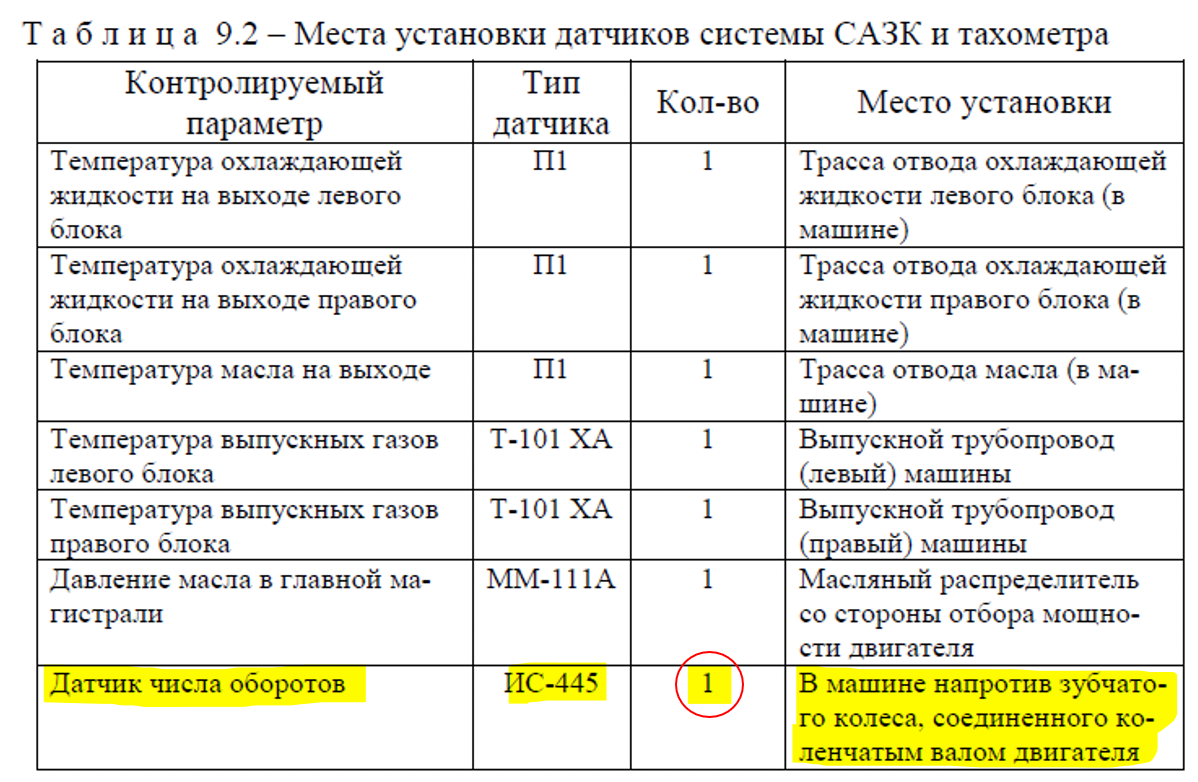
Another document proved decisive. In a request from Uralvagonzavod’s commercial director to ZOMZ, the company outlined long-term procurement plans running from 2027 through 2036. The letter, available in full at the end of this report, contained detailed annual projections not only for new production but also for capital overhauls (CO) and modernization (M). Crucially, the numbers covered both T-72 and T-90 variants, including the new T-90M2.
The table below shows aggregated numbers from the same document, breaking down annual production, overhauls, and modernization per vehicle type. Not all tanks listed are new builds; the totals include capital overhaul (CO), modernization (M), and production (P), which we have marked accordingly. The presence of capital overhauls in the list also indicates that when restoration work is carried out on tanks, new parts are ordered rather than using existing spares. This suggests that even if the order invoice includes some spare components, their number is minimal and statistically insignificant in the overall picture.
The figures reveal a sharp ramp-up beginning in 2027, with peak output in 2028, when 428 T-90M and T-90M2 tanks are scheduled - a nearly 80% increase compared to 2024 levels. Between 2027 and 2029 alone, Russia plans to produce, overhaul, or modernize 1,118 T-90M and M2 tanks.
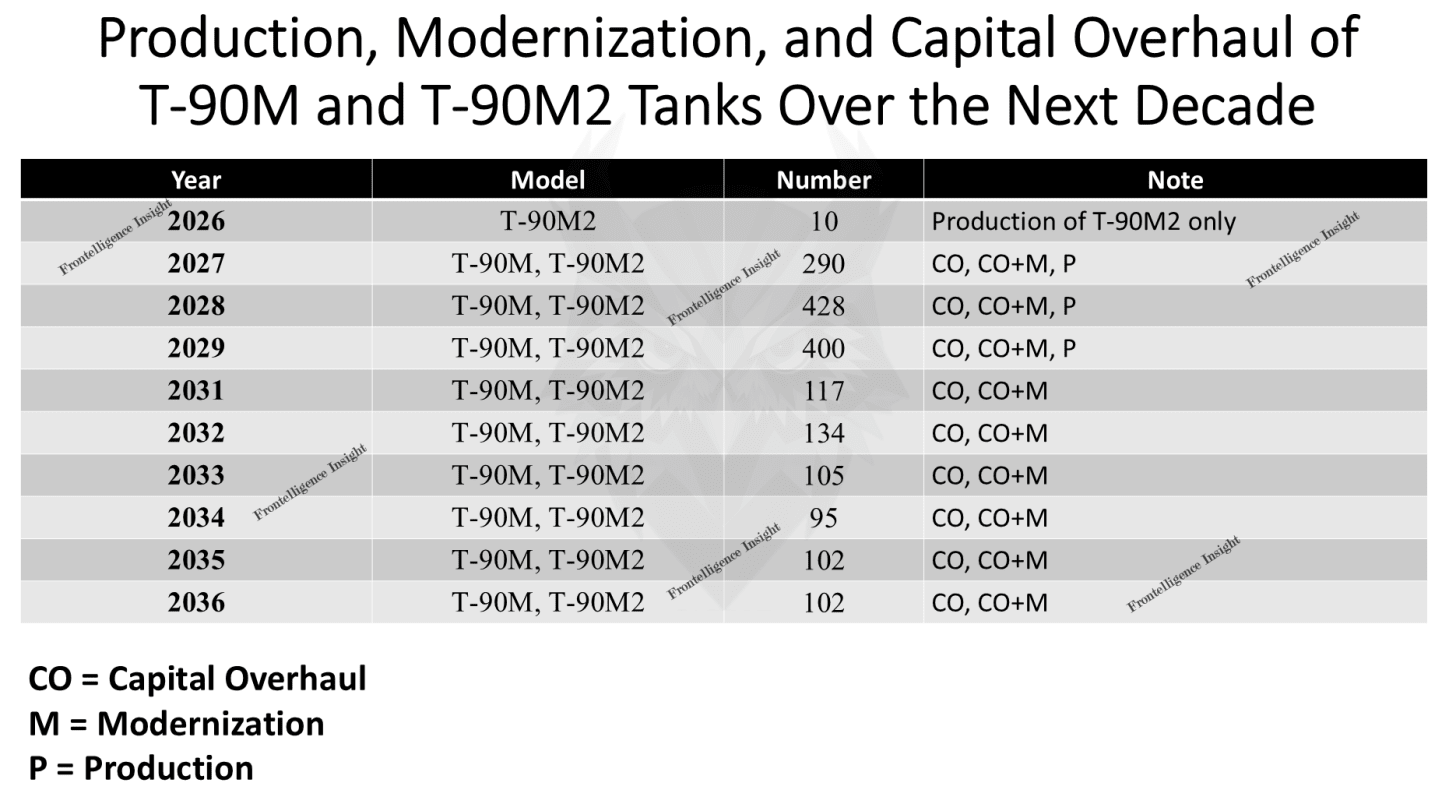
Even if production falls 30% short of target, that still equates to more than 780 modern tanks in just three years. Over the entire decade, Moscow’s target is at least 1,783 T-90M and T-90M2 units.
There are a few unusual details in the schedule. Most notably, the year 2030 is entirely absent - not only for new production, but also for overhauls and modernization. Equally striking, 2029 is the last year with any “P” (production) entries.
After that, orders appear to cover only parts for overhauls and upgrades, with no new production listed. The reason for this gap is unclear. Our team has speculated that 2030 may be reserved for factory reorganization, expansion, or modernization, which could explain the missing year. Once such changes are complete, production could resume under an updated schedule. We see little reason to assume that Russia will halt new tank production, thus it is more likely that the plan after 2029 represents a minimal projection rather than a full production schedule. For now, however, these interpretations remain speculative.
Another plausible explanation came from one of the experts we consulted. He suggested that the absence of production beyond 2029 could reflect plans for a new variant or update of the T-90 around that time, making it unnecessary to reserve production capacity so far in advance. It is also possible that the broader armament program has not yet been finalized, so committing to a decade-long production contract could be impractical.
III. T-72: Old but Modernized
The document also includes procurement data for T-72 parts, though our confidence in these figures is lower than for the T-90. The parts differ from those used in T-90 models, specifically, T-72 modernization program requires the supply of the cold-bore sighting tube TKHP-12-150, making it harder to determine whether each ordered unit corresponds to a single tank, and how many spares they might order. We interviewed several Ukrainian tank crew members, who confirmed that each tank and other armored vehicles carries one of cold-bore tubes. While this small, anecdotal sample is not definitive, it provides a reasonable basis for preliminary estimates. Thus, if we assume one part per tank, the resulting picture would be as follows:
Essentially, the data indicate that Russia plans to overhaul and modernize a total of 828 vehicles into the T-72B3M configuration by 2036. As with the T-90M and T-90M2, peak activity is scheduled around 2028, with 498 T-72B3M units expected to be produced or upgraded between 2027 and 2029. If we combine these figures with projected T-90 variants, the total rises to 2,611 tanks as a baseline for the 2026–2036 period - enough to fully modernize and update Russia’s tank fleet. However, because we are less confident in the methodology for calculating the T-72 figures, we have chosen not to include this number in our final summary.
IV. Terminated?
The BMPT “Terminator” is an armored fighting vehicle built on the chassis of the T-72 main battle tank. Designed to support tanks and other armored vehicles both in field and urban combat, it is easily recognizable by its twin 30mm 2A42 autocannons. Yet after more than three years of full-scale war, the vehicle has seen only limited use, with just a handful of recorded deployments and at least one confirmed destruction.
Scarce information about the program has fueled speculation about its future. These newly obtained documents suggest the skepticism was justified: compared with other platforms, BMPT production appears extremely limited, with only 86 vehicles slated for overhaul and production between 2027 and 2036.
Summary
The documents provide a useful baseline for understanding how Russia’s military and political leadership envisions the coming years. They also suggest that Moscow has no plans to seriously downsize its current, already expanded army
Russia is estimated to have produced roughly 240 T-90M tanks in 2024 and believed is on track for a similar figure in 2025. Even accounting for battlefield losses, the net effect appears to leave Moscow with more operational T-90M tanks than before. Combined with more restrained use of armor on the battlefield this year, the buildup suggests the Russian army may require far less time to replenish its tank park than many analysts assumed. It also underscores that Russia retains the capacity to sustain a war of aggression, despite the mounting costs of its campaign in Ukraine.
Beyond the T-90 program, Russia is pursuing a range of additional projects, including the development of projects such as the “Shturm,” an unmanned tank designed for urban combat, and other robotic ground vehicles capable of carrying weapons. These systems may not play a decisive role in the current war, but they signal a broader trend: Moscow’s shift toward expanding the role of unmanned systems - on land, at sea, and in the air.
Of course, plans are not guarantees. Production targets can slip, resources can fall short, and some programs may never reach scale. But dismissing Russia’s rearmament efforts outright would be a mistake. The scale of the planned programs implies major financial commitments as well as significant imports of both components and industrial equipment. As Moscow continues to adapt to sanctions, the West faces an urgent task: tightening pressure on Russia’s economic, technological, and financial choke points. Slowing down Russia’s military-industrial machine may not end the war, but it could delay the refitting of Moscow’s arsenal, limiting its ability to threaten Europe and the broader West, while buying time to prepare for a potential conflict.
Thank you for reading. Access to the repository containing the exclusive files used in this research is available below for all paid subscribers:
